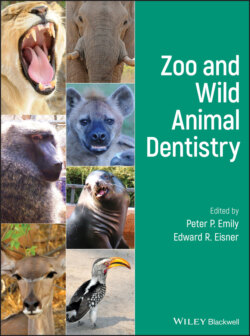Читать книгу Zoo and Wild Animal Dentistry - Группа авторов - Страница 11
Оглавление
Foreword
I am pleased to write this foreword for Drs. Emily and Eisner's textbook, the first entirely dedicated to zoo and wild animal dentistry.
Ever since I met Dr. Emily for the first time in the 1980s, we have enjoyed stimulating discussions on comparative odontology and I am grateful to him for introducing me to Osborn's concept of tribosphenic molar teeth. I also share with him and Dr. Eisner a strong interest in oral pathology occurring in animals and a curiosity about natural history in general, and its relation to dentition and dental pathology in particular. Since then, my research and teaching interests have directed me more to comparative dental pathology and odontology, respectively, while the authors have spearheaded clinical dentistry in zoo and wild animals, for which they should be commended.
Dentistry is, or should be, an essential part of the veterinary care of zoo and wild animals in captivity, both in terms of preventative care as part of their long‐term husbandry, and in addressing dental conditions as they occur. The latter is the focus of this book. Great advances have been made in the practice of dentistry in domestic animals over the past decades. Zoo and wild animals should also benefit from these advances. There is no reason to believe that pain of dental origin, be it acute or chronic, is any less severe and debilitating in animals than it is in humans, greatly affecting their quality of life. The basic premise of being a veterinarian is to prevent and address pain in animals entrusted to our care. The stakes and challenges are particularly high in zoo and wildlife dentistry. Even under the best of circumstances and with the best of intentions of the care‐takers, captivity of wild animals typically is associated with unphysiological conditions in terms of environment and diet. Wild animals in captivity must be housed in safe facilities – unfortunately, the combination of fences and boredom can cause significant dental injury. The human‐animal bond in this case has two components: the zoo's animal care‐taker has a very strong personal bond while the zoo's administration and the public typically would like to see an animal on display with an intact dentition.
Though the use of non‐evidence based and non‐FDA‐approved materials and instruments should not be promoted, it is an unavoidable fact that procedures on non‐domestic species may require medications and instruments that are not FDA‐approved for use in those species. In addition, some dental materials, such as MTA, are cost‐prohibitive to use in large volumes; hence “Dr. Emily's MTA's recipe”, which I found to exemplify this book: empirical, practical and helpful. The practicality and helpfulness are important, given the fact that getting the procedure done in a timely fashion is especially important in these animals, in order to minimize the duration of anesthesia.
This is an important textbook and addition to the veterinary dental and zoological medicine literature. While this book is not an authoritative textbook on comparative odontology, like Berkovitz and Shellis' The Teeth of Mammalian Vertebrates (2018), nor a historical treatise on comparative dental pathology, like Colyer's Variations and Diseases of the Teeth of Animals (1936), it is a very practical compilation of the authors' many years of clinical experience treating dental problems in captive wild animals. Veterinary dentists may get called upon to see one of a species once in their career. The authors of this text have seen at least one case of the diseases and species described, and have generously shared their experience with their readers.
Frank J. M. Verstraete
DrMedVet BVSc MMedVet Dipl AVDC Dipl EVDC Dipl ECVS AVDC‐ZWD FF‐AVDC‐OMFS
Professor of Dentistry and Oral Surgery
Department of Surgical and Radiological SciencesSchool of Veterinary MedicineUniversity of California—Davis
